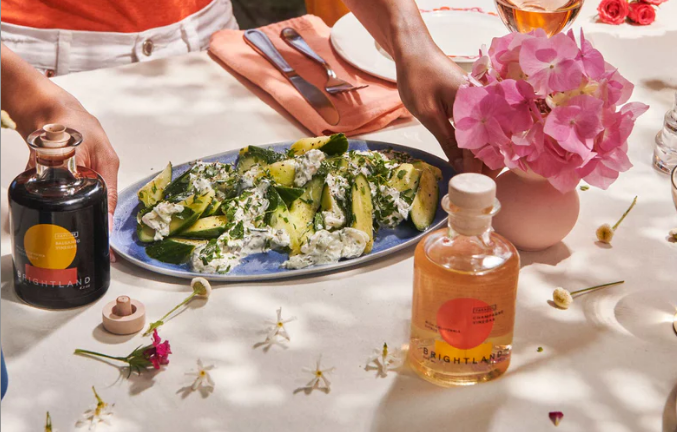If you have an entire collection of vinegars, but have only been using them to make homemade salad dressings, then you are really missing out on how much vinegar can offer to your cooking and baking. Here are seven delicious and unexpected ways that you can combine flavored vinegars with food, plus some bonus tips for mixing vinegar into beverages:
Meats
Vinegar is an excellent addition to any homemade marinade for meats — as well as tofu, tempeh and other plant-based meat substitutes. Not only does vinegar add a lot of big flavor to the meat or tofu, the acid in it also breaks down the meat and helps to tenderize it. For best results, use only one to two tablespoons of vinegar per serving of meat depending on how strong of a vinegar you are using. Soak the meat for one to two hours right before cooking — any longer than that and the vinegar can alter the texture of the meat too much, making it tough instead of tender.
Vegetables
Bored of eating plain vegetables? Shake them up with different kinds of vinegar and soon you will look forward to eating your daily serving of greens. Fortunately, there are many fabulous ways to cook vegetables with vinegar. One of our favorites is quick pickling fresh summer vegetables in the fridge using a lighter colored vinegar such as apple cider or champagne vinegar. If you prefer to use a stronger vinegar such as balsamic, it makes for an excellent glaze for root vegetables (like potatoes and carrots) just before roasting them in the oven. The vinegar will caramelize in the heat, adding delicious flavor to the vegetables and transforming them from an afterthought to the star of the meal.
Fruits
Vegetables are a more obvious food to pair with vinegar, but you might be hesitant to combine fruit with vinegar. After all, fruits are known for being sweet, and most vinegars have a reputation for being sour. So how can they go together? But vinegar can actually be the perfect complement to fruit, turning it into a tasty yet healthy snack or dessert. Delicate vinegars like champagne vinegar provide a counterpoint to fresh fruit’s sweetness all by themselves. Meanwhile, balsamic makes a delicious glaze for fruit when combined with honey, especially if you roast the fruit after glazing it to bring out the flavor even more.
Soups and Stews
If your soups and stews come out tasting a little flat, then you probably are not finishing them properly. Finishing off a soup with a few final additions — whether that is a splash of cream or a pinch of fresh herbs — is what adds that final flavor, and a touch of vinegar is sometimes just the thing you need to take your soup from tasteless to tangy. You can mix the vinegar directly into the pot, or ladle the soup into individual bowls and then add a decorative swirl on top just before serving to your guests. The swirl visual effect works best with a light colored soup and a dark colored vinegar like malt or balsamic.
Grains
You have probably added vinegar to a cold pasta salad at some point, but it pairs with so many other grains besides just plain noodles. For instance, instead of dousing your rice in plain soy sauce, you can whip together a quick sauce consisting of soy sauce, vinegar and maple syrup to add more depth of flavor to it. Vinegar is also a fantastic addition to any dressing for a grain salad because it pairs well with both grains and greens. If you have been getting into warm bowls lately, definitely keep vinegar in your ingredient rotation.
Dairy
Dairy products are delicious, but sometimes you need another ingredient to balance out the creamy fattiness, and that is where the acidity of vinegar comes in. Vinegar can be used on everything from eggs to cheese to yogurt. For eggs, you can mix a splash into your scramble or even pickle the eggs in a vinegar solution. Balsamic vinegar also makes a great sauce for plain Greek yogurt, and the Italians are also known for pairing it with parmesan cheese to help get through the fattiness. If you have not yet experimented with pairing dairy with vinegars, dare to be adventurous and learn what you have been missing out on!
Desserts
Dessert might be the last way you would think to use vinegar, but it is actually the perfect way to shake things up if you are tired of overly sweet after-dinner treats. We already talked about using vinegar in a glaze for roasted fruit, but you can also use it as a topping for ice cream or sweet parfaits — or combine it with fruit to create a delicious sauce for another dessert. A tablespoon of apple cider vinegar is also the secret weapon to making a perfectly flaky pie crust from scratch. It will help to prevent overworking the dough and also keeps it from oxidizing in the fridge while it chills.
Drinks
We know that drinks are not technically food, but we could not finish up this list without mentioning ways that you can pair beverages with vinegars. If you constantly use lemons and limes in your homemade cocktails, try switching to vinegar as your acid instead to shake things up. You can also make non-alcoholic drinks infused with vinegar, fruit, honey and other tasty ingredients for a refreshing yet healthy beverage that is free of sugars and chemical additives.
What are your favorite ways to pair vinegar with foods? Do you have favorite recipes that call for vinegar in some capacity? Let us know in the comments below!


